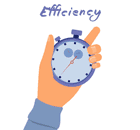The Bucket System Estimation Technique – A Detailed Guide
The Bucket System estimation technique is a simple, fast, and effective estimation technique for large product backlog items. Find out more in-depth details about this technique in this article.

Agile methodology is seeing unprecedented popularity among organizations no matter what industry they belong to. Agile eradicates the traditional way of product development and implements a more iterative-based development approach. One stage in agile-based development is "estimation", which plays a crucial role in timely and quality deliveries. Agile estimation is the process of estimation of efforts required to complete prioritized items/tasks in the product backlog.
There are multiple techniques available today to conduct agile estimation. So, organizations can pick any estimation technique depending on their development approach and product needs. However, for large product backlog items or for teams that want to quickly do estimates of backlog items, organizations use the Bucket System estimation technique to have both fast and accurate estimates. Therefore, this article will discuss the Bucket System estimation technique in detail including the steps to follow and all other resourceful details around it. So, let's jump right to it!
What is the Bucket System Estimation Technique?
The Bucket System estimation technique is a relative estimation technique that best suits when there is a need to estimate a large number of product backlog items. The Bucket System can incorporate a large team in the estimation process and ensure fast and accurate estimates.

Async Poker for Jira

Sync Poker for Jira
In the Bucket System technique, the bucket represents numbered sticky notes that are placed on the wall or table in a sequential manner. The bucket numbers mostly range from 0-200, such as 0, 1, 2, 3, 4, 5, 8, 13, 20, 30, 50, 100, and 200. The team discusses the items to be estimated, places them under those numbered sticky notes (buckets), and reaches the final team's estimate. Overall, Bucket System presents a simple and fast way of estimating large stories count. Usually, when the stories count is greater than 40 but less than 500, the Bucket Estimation technique seems best to estimate effectively and efficiently.
Steps Involved in the Bucket System Estimation Technique
For newcomers in the agile-based development, The Bucket System estimation technique presents as the simplest estimation technique they can understand and deploy easily. Following are the steps agile teams have to follow to execute the Bucket System estimation technique rightly:
- Arrange a team meeting and gather all the members in an on-premises meeting room. Arrange numbered sticky notes on the table or whiteboard. You can number them as 0, 1, 2, 3, 4, 5, 8, 13, 20, 30, 50, 100, and 200 or in other numbering formats as you like. The preferred format is to use the Fibonacci sequence. Moreover, the meeting facilitator should have written all the items to be estimated on the card or piece of paper so that they can be placed under the buckets.
- Pick one item randomly, read it to the team, and then put it under the bucket that is labeled "8". This story will now be used as the reference for all other stories. For example, if the next story is less difficult than this one, then it will be placed under the bucket whose value is lower than 8.
- Pick another item randomly and read it to the team including all its requirements and features. The team finalizes its position in the bucket compared to the item placed in Bucket 8. Afterward, the item is placed in the agreed bucket.
- Pick another item randomly, discuss it, reach a consensus, and place the item in the appropriate bucket.
- If the random selection of items has skewed the scale to one end, then the team should re-scale the items. For example, if the team realizes that the first item is very small, then it should be placed in the "1" bucket.
- Divide the remaining items equally among all the members participating in the estimation. Every member reads the item on their own and places it under the appropriate bucket without discussing it with others. In case a member finds an item that is difficult to understand, then he/she can hand it over to another member.
- Once all the items are placed under buckets, then all members quietly review the items and ensure that they are placed rightly. If someone finds that an item is not placed in the right bucket, then the team can quickly discuss it and reach a consensus.
- Once the estimates of all items are final, write the bucket numbers on the items cards to record the estimate.
That's it! This way, any agile team can quickly deploy the Bucket System estimation technique to easily estimate product backlog items. However, there are a few important points to consider for accurate estimates, such as:
- No item should be placed between the two buckets for precise estimation.
- Each bucket can have multiple items.
- If the items are skewed to one side of the scale, then the team should try to re-size the items to spread them out in a better way.
- The items can be divided among team members roughly, and there is no such need for mandatory equal division of items.
- The facilitator or the moderator should ensure that the estimated items under the bucket are not moved until all the items are estimated.
- If a few members are taking extra time in estimating their assigned items, then they can collaborate with other members who have finished their estimates to speed up the process.
- During both the individual estimation stage and the final verification stage, there should be absolute silence so that members can focus properly.
- At the end of the estimation, the items in each budget should be arranged in a prioritized manner.
In short, any agile team can use the Bucket System estimation technique, just it should adhere to the above points to ensure accurate estimates.
Key Benefits of the Bucket System Estimation Technique
The Bucket System estimation is used by many agile teams today owing to its simplest estimation nature. Other than that, some of the key benefits of the Bucket System estimation technique are as follows:
- It offers fast estimates of items because the items are divided among members and estimated individually.
- It saves significant time in estimating a large number of product backlog items owing to its "divide and conquer" approach. In short, it reduces hours of work to just a few minutes.
- It helps new Agile teams to estimate product backlog items with ease.
- It does not let the team start deep discussions, which just consumes more time and impacts productivity.
- It is based on relative estimation, thereby offering more accurate estimates.
To sum up, the three key benefits of the Bucket System technique are speed, support for large backlog items, and simplicity.
Alternatives to the Bucket System Estimation Technique
For accurate estimates, it is important that you pick the right estimation technique that best suits your business model. The Bucket System technique is found to present accurate estimates, but some teams might struggle with it due to different business approaches. So, the preferred approach is that you try the Bucket System estimation technique first and see the accuracy of your estimates. However, if the estimates are inaccurate, then you can use other agile estimation techniques, such as Planning Poker, Affinity Mapping, T-Shirt Size, Dot Voting, etc.
Among all the agile estimation techniques other than Bucket System, Planning Poker is the most widely used technique. Planning Poker is also a relative estimation technique that uses poker cards to estimate backlog items. The members are provided with poker cards with the numbers mostly in the Fibonacci sequence (0, 1, 2, 3, 5, 8, 13, and 21) that they have to assign to each item. The product owner reads the story, the team discusses the story, and then shows the card (narrating the effort level) altogether. If everyone has selected the same card, then that value is the estimate of that item. Otherwise, the team quickly discusses again to reach a consensus. The process continues until all the items are estimated. Some teams even use the modified Planning Poker technique, i.e., Asynchronous Planning Poker or Async Poker, to estimate backlog items if the team members are distributed or working remotely.
Wrapping Up
In agile methodology, estimation is an important step that helps the team to have a better view of the efforts required to complete the upcoming project. The Bucket System estimation technique is the simplest and super-fast way of estimating the large number of backlog items. Moreover, the teams that are new to agile or have a busy work schedule can also find the Bucket System technique a quick and efficient way of estimating backlog items.




